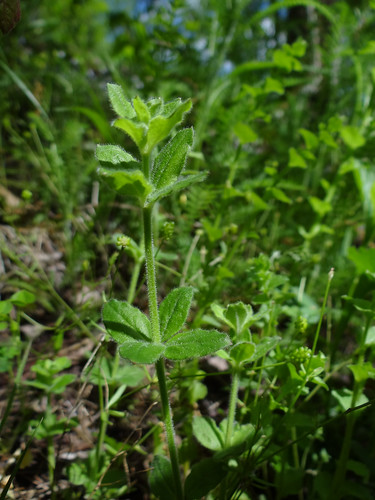 Species Factsheets
Species Factsheets
Galium latifolium
Purple Bedstraw
State Status: Pennsylvania Threatened (PT)
PBS Status: Pennsylvania Threatened (PT)
Federal Status:
Global Rank: G5
![]() rank interpretation
rank interpretation
State Rank: S2
Description
Purple bedstraw (Galium latifolium) is a perennial herb with erect to reclining, four-sided stems that can reach up to 60cm long. The leaves are 3-6cm long, widest near the base and tapering to the tip, have three prominent veins, and are arranged in whorls of four along the stem. The flowers, which are very small and have four purple lobes with long pointed tips, bloom from June to July and are arranged in open, branched clusters that grow from the upper stem nodes. The 3-4mm round fruits can have a smooth or grainy surface, distinguishing them from related species of bedstraw that have bristly fruits.
Rank Justification
Imperiled in the nation or state because of rarity due to very restricted range, very few populations (often 20 or fewer), steep declines, or other factors making it very vulnerable to extirpation from the nation or state.
PABS
The PA Biological Survey considers purple bedstraw to be a species of special concern, based on the relatively few occurrences that have been confirmed. It has been assigned a rarity status of Undetermined, meaning that more information is needed before a more definitive rarity status can be designated.
Habitat
The species grows in dryish to moist woodlands, especially on shale and sandstone substrate.
Survey Dates
Flowers June - July
Distribution
In Pennsylvania, most occurrences are in the south-central counties in the Ridge and Valley province.

Management
More field surveys are needed to determine the range, abundance, and ecological requirements of the purple bedstraw before a more definite conservation status, if needed, can be assigned.
Conservation Status Map

NatureServe. 2017. NatureServe Explorer: An online encyclopedia of life [web application]. Version 7.1. NatureServe, Arlington, Virginia. Available https://explorer.natureserve.org.
- NatureServe. 2018. NatureServe Explorer: An online encyclopedia of life [web application]. Version 7.1. NatureServe, Arlington, Virginia. Available at https://www.natureserve.org/explorer
- Pennsylvania Natural Heritage Program. 2018.
- Rhoads, A.F. and W.M. Klein, Jr. 1993. The Vascular Flora of Pennsylvania. American Philosophical Society, Philadelphia, Pennsylvania. Rhoads, A.F. and T.A. Block.
- 2007. The Plants of Pennsylvania: An Illustrated Manual. 2nd edition. University of Pennsylvania Press, Philadelphia, Pennsylvania.







